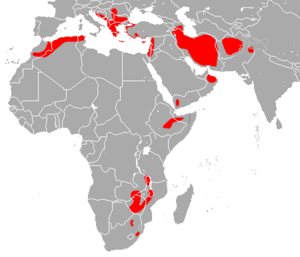Blasius's horseshoe bat facts for kids
Quick facts for kids Blasius's horseshoe bat |
|
|---|---|
 |
|
| Conservation status | |
| Scientific classification | |
| Genus: |
Rhinolophus
|
| Species: |
blasii
|
 |
|
| Blasius's horseshoe bat range | |
The Blasius's horseshoe bat (Rhinolophus blasii) is a fascinating type of bat that mainly eats insects. You can find these bats in many areas around the Mediterranean Sea, the Middle East, and parts of Africa. They are known for their special nose shape, which looks a bit like a horseshoe and helps them find their prey using sound.
Contents
How Blasius's Horseshoe Bat Got Its Name
In 1866, a German scientist named Wilhelm Peters officially described this bat as a new species. The very first bat he studied to describe it came from Italy. The bat was named "blasii" to honor another German zoologist, Johann Heinrich Blasius.
What Does It Look Like?
Blasius's horseshoe bats are quite small, especially for bats found in Africa. Their forearms, which are the main bones in their wings, are about 43 to 48 millimeters long. That's roughly 1.7 to 1.9 inches. When it comes to weight, they are very light, usually between 7 and 13 grams. This is about the same weight as two to four US pennies.
What Do They Eat and How Do They Live?
Blasius's horseshoe bats are insectivores, meaning they love to eat insects! Their favorite meals include moths, termites, beetles, and flies. They have two clever ways of catching their food:
- Hawking: This is like catching insects right out of the air while they are flying.
- Gleaning: This means they pick insects off leaves or the ground.
We don't know a lot about their social lives. Sometimes, they roost (rest) alone, and other times, they are found in small groups. In Malawi, people have seen up to five bats hunting for food together. These bats usually have one breeding season each year, and the female bats give birth to just one baby at a time.
Where Do They Live?
Blasius's horseshoe bats can be found in many different places, from sea level up to about 2,215 meters (7,267 feet) high. Even though they live in a very large area, their populations are spread out in patches. Their home range includes parts of Africa, Asia, and Europe. Sadly, they are no longer found in Italy, and they might also be gone from Slovenia. These bats can live in many different types of environments, such as deserts, savannas (grassy plains), shrublands, and forests.


